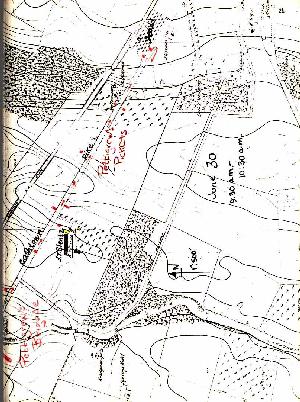
June 30 9:30-10:30 A.M.
The invasion of Lee's Army of Northern Virginia was followed closely by readers of the Gettysburg
Compiler and the Star and Sentinel. When Jubal A. Early's Confederate Division came down the Cashtown
turnpike and clashed with first the 26th Pennsylvania Emergency at Marsh Creek and then the 21st
Pennsylvania Cavalry in the very town itself, Gettysburg's citizens and farmers became aware of the terrible
reality of war. James McAllister, abolitionist miller and farmer, tended the first of many bodies which would
dot the property when he picked up a dead young cavalryman from near his boundary line at Rock Creek on
the Baltimore Pike and put him in the bed of his wagon. Not knowing who
22
the young man was, he inquired of his neighbors and was told it was the Sandoe boy. McAllister brought
his melancholy cargo to the Sandoes that afternoon--the first of Gettysburg's families to be tragically touched
by the battle.
It is not recorded what John Slentz and his family did on this preliminary day of invasion. We assume that a Rebel division would have been frightening enough (at least it was to the 26th Militia and 21st Cavalry) to induce the Slentzes to hightail it for "safer" environs in the town, relieving them of the comparative isolation of their farm west of the town.
When Early left the next morning, things returned to normal (as normal as could be expected anyway), and the Slentz family returned to their home. On Tuesday, June 30, there was another scare. This time A. P. Hill's Corps of Lee's army was stationed around Cashtown, about eight miles west of Gettysburg. A brigade under command of Joseph Pettigrew was dispatched from Heth's Division to Gettysburg with fifteen wagons 42 in an attempt to bleed the little coach-making town of supplies (shoes especially). Pettigrew took along a battery of artillery for "intimidating" purposes and as an insurance for his infantry in case they ran into some more of the militia units. 23 About 9:30 in the morning a line of Pettigrew's soldiers "at least a mile and a half in length" 43 advanced haltingly along the Cashtown Pike. Most of the brigade pulled up short of Willoughby Run, waiting for the line of two dozen or so pickets to give them the signal if it was safe to advance. The pickets questioned residents along the pike towards Gettysburg, Slentz probably being one of those subjected to this interrogation. This thin line of advance got as far as the Robert Sheads house before they hurried back to their lines. From Seminary, or Stoney, Ridge they could see the head of Buford's U.S. cavalry loping northward along the Emmitsburg Road and into the outskirts of town. Seeing Buford's Second Brigade in the lead and another one directly behind it, the pickets reported to Pettigrew that there was "a large force of cavalry near the town, supported by an infantry force".44 Isolated from the main force of his army, Pettigrew was uneasy about becoming engaged with a potentially superior force. He withdrew his own infantry to Marsh Creek, then audaciously decided to entrap any cavalry pursuit by setting up a "decoy" for Buford, wherein "two regiments defiled under cover of a hill, one to the right of the road, the other to the left, whilst a third was sent a short distance forward to induce a pursuit". 45

June 30 9:30-10:30 A.M.
43 Ibid., p. 22.
Return to Text
44 Official Records of the War of the Rebellion, Series I, Vol. 27, part 2, p. 637. (hereafter
cited as OR).
Return to Text
45 Jacobs, p. 22.
Return to Text